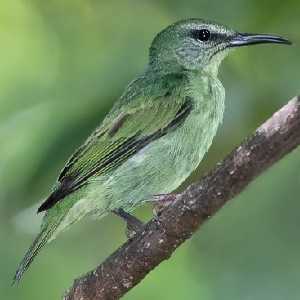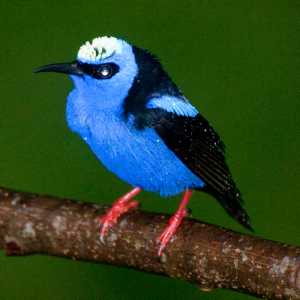  Red-Legged Honeycreeper Red-Legged HoneycreeperCyanerpes cyaneus
Description
During the breeding season, males of this
species are very visible, with bright blue
underparts, black wings, back, and eye mask, and
bright red legs. The crown of its head is
turquoise, and the underwing, visible only in
flight, is lemon yellow. Outside of the breeding
season, however, the male is green overall, with
black wings, tail, and eye mask, and brownish
legs. Females are green year-round, with brown
legs and eye stripes. Juveniles are similar to
females in coloration.
Both sexes are roughly similar in size, with a
length of about five inches and weight of less
than an ounce.
Distribution and
Habitat
Red-legged honeycreepers are
fairly common from southern Mexico to Argentina,
as well as on the islands of Cuba, Trinidad, and
Tobago. They prefer the canopy and
sub-canopy of tropical rain forests but are also
found in secondary woodlands, as well as
clearings with scattered trees and shrubs. They
choose broadleaf trees over pine species, mostly
below 3,600 feet, but are seasonally found at
higher elevations. They are also common in
residential areas and cocoa and citrus
plantations.
Reproduction
Red-legged honeycreepers breed
from January to June, depending on location. The
cup-like nest, built by the female, is suspended
by its rim from a twig up to 50 feet off the
ground. Two white eggs with brown markings are
incubated by the female for 12-13 days. The young
are fed by both parents until fledging at about
two weeks of age.
Diet
The red-legged honeycreeper usually forages in
the canopy, searching for insects on small
branches, or catching them in flight. It also
feeds lower, picking ripe fruits and eating the
seeds inside. Its recurved bill allows it to
extract the pulp of an orange (or other fruit)
through holes made by woodpeckers, as well as to
take nectar from flowers.
Other Information
Red-legged honeycreepers are rarely seen
alone, preferring to gather and travel in flocks
of up to twenty individuals. It is not uncommon
for flocks of a hundred or more to congregate at
rich food sources, such as flowering trees.
Some populations are resident year-round,
while others migrate during the winter. Those
that do migrate do not travel far, however,
generally moving down to lower altitudes rather
than flying long distances.
Scientific
Classification
phylum Chordata
subphylum Vertebrata
class Aves
order Passeriformes
family Thraupidae
genus & species Cyanerpes cyaneus
Questions or comments about
this page?
|



